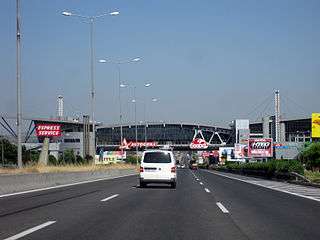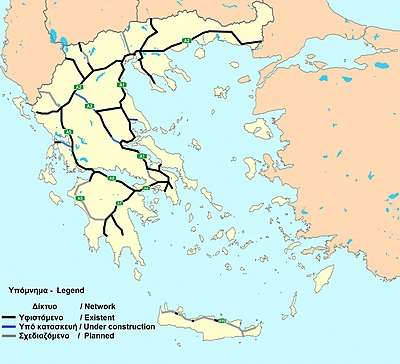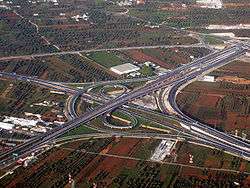National Roads and Motorways in Greece
The National Roads and Motorways in Greece constitute the main road network of the country. These two types of roads are distinct in terms of their construction specifications. Their main difference is that motorways (Greek: Αυτοκινητόδρομοι) adhere to higher quality construction standards than National Roads (Greek: Εθνικές Οδοί).

For example, a typical motorway (highway) in Greece consists of six or four lanes (three or two lanes in each direction) plus an emergency lane, separated by a central barrier. Entrances and exits to the motorways are only provided at grade-separated junctions (interchanges) and there are no traffic lights. Greek motorways are generally organized so that the odd-numbered motorways are of north-south alignment and the even-numbered motorways are of east-west alignment. However, there are many exceptions.
A typical National Road in Greece is usually a single carriageway or limited-access road with at-grade intersections and with one or two traffic lanes for each direction, usually with an emergency lane on each side as well. The designation of some important roads of Greece as "national" was first decided by a 1955 decree, while a minister's decision in 1963 determined the numbering of these roads. In 1998, a survey of the Hellenic Statistical Authority defined some new national roads that were constructed after the 1963 decision.
The naming system of motorways and National Roads is different. For example, "A2" refers to the Egnatia Odos motorway, while "GR-2" refers to National Road 2. All motorways are named by using the capital letter "A", followed by a number (e.g. A1). The main motorways of Greece have a single digit number and auxiliary motorways perpendicular to the main ones have a double digit number (e.g. A25). Motorways have their own white-on-green signs, while National Roads are designated by white-on-blue signs.
The construction of the Greek motorway network has been, to a large extent, a very complex and demanding project due to the peculiarities of the geomorphology of the areas through which the new roads pass. The Greek mainland is extremely mountainous;[1] the local topography as well as environmental concerns regarding the local flora and fauna played a decisive role in the final route design. In order to overcome these difficulties, the construction of multiple large and expensive technical works, such as tunnels and bridges, was necessary in many cases. Indicatively, the total number of tunnels built along the four Greek major highways (A1, A2, A5, A8) is about 150 and their total length is about 200 km (measured as a single bore).[2][3][4][5][6]
With a total length of about 2500 km as of 2020, Greece's motorway network is the biggest one in Southeastern Europe and one of the most advanced in Europe.[7]
Motorways


Greece's motorway network has been extensively modernized throughout the 2000s and part of it is still under construction. Most of it was completed by early 2017. There are a total of 10 main routes throughout the Greek mainland and Crete, from which some feature numerous branches/auxiliary routes, as described in the listing below.
Greek motorways according to ministerial decree of 2015
| Name | Connecting cities | progress | notes |
|---|---|---|---|
Athens - Thessaloniki - Evzonoi |
Athens, Thebes, Chalkis, Lamia, Volos, Larissa, Katerini, Thessaloniki | 550/550 km
342/342 mi |
Completed
Section Chalastra - Evzonoi is an expressway |
Egnatia Odos |
Igoumenitsa, Ioannina, Grevena, Kozani, Veria, Thessaloniki, Kavala, Xanthi, Komotini, Alexandroupoli | 670/670 km.
416/416 mi. |
Completed |
Central Greece Motorway |
Lamia, Karditsa, Trikala | 80/175 km
50/109 mi |
Section Trikala - |
Ionia Odos |
Patras, Missolonghi, Arta, Ioannina | 196/196 km
122/122 mi |
Completed |
Attiki Odos |
Attica | 48/48 km
30/30 mi |
Completed |
Central Peloponnese Motorway |
Corinth, Argos, Tripoli, Kalamata | 149/149 km
93/93 mi |
Completed |
Olympia Odos |
Athens, Corinth, Patras | 205/279 km
127/173 mi |
|
Schimatari - Chalkis |
Chalkis | 11/26 km
7/16 mi |
Chalkis bypass is under planning |
Velestino - Volos |
Volos | 0/40 km
0/25 mi |
Upgrade under planning |
Thebes - Eleusis |
Thebes, Eleusis | 0/40 km
0/25 mi |
Under planning. |
Thessaloniki - Nea Moudania |
Thessaloniki, Nea Moudania | 72/72 km
45/45 mi |
Completed
No emergency lane, green signs |
Thessaloniki - Serres - Promachonas |
Thessaloniki, Serres | 105/105 km
62/62 mi |
Completed
Section Kato Christos - Sidirokastro upgrade under planning |
Kozani - Ptolemaida - Niki |
Kozani, Ptolemaida, Florina | 40/79 km
25/49 mi |
Sections Kozani - Ptolemaida and Florina - Niki completed
Section Ptolemaida - Florina under planning to be upgraded |
Siatista - Krystallopigi |
Kastoria, Kozani, Florina | 72/72 km
45/45 mi |
Completed |
Aktio - Amvrakia |
Vonitsa, Aktio | 15/49 km
9/30 mi |
Section Vonitsa - |
Ymittos - Rafina |
Attica | 13,5/20 km
8,4/12 mi |
Completed
Sections Pikermi - Rafina and southern expansion under planning |
Koropi - Aerodromio |
Athens International Airport | 6/6 km
4/4 mi |
Completed |
Lefktro - Sparti |
Tripoli, Sparta | 45,5/45,5 km
28/28 mi |
Completed |
Northern Cretan Motorway |
Chania, Rethymno, Heraklion | 41/310 km
25/193 mi |
Upgrade under construction/planning |
Raidestos - Thessaloniki International Airport |
Thessaloniki | 3/3 km
2/2 mi |
Completed
Pre-existing section is not a motorway |
Attiki Odos western branch |
Attica | 2,5/2,5 km
1,6/1,6 mi |
Completed |
A1 (Athens - Thessaloniki - Evzonoi)
Motorway 1 (![]()
The full length of this motorway is around 553 km or 346 miles, including 14 km or 8.7 miles of shared route with the A2 (Egnatia Odos). Note that until recently, the "P" in "PAThE" referred to Patras, but the Patra – Athens section has now become part of the A8 (Olympia Odos) motorway, belonging to a different project.[8][9]
- Motorway 11 (

- Motorway 12 (

- Motorway 13 (

A2 (Egnatia Odos)
Motorway 2 (![]()
Specifically, there are auxiliary routes to Albania and Bulgaria, with the main route leading to Turkey. North Macedonia is accessed through the A1 (PAThE), as described above, or via Motorway A27 (see below). Another auxiliary route runs close to the Evros river in the prefecture of the same name, reaching a point where Greece's, Turkey's and Bulgaria's borders meet. Some of those auxiliary routes are not yet motorways, but typical 2-lane expressways, although they are of considerably higher quality than other similar expressways in the rest of Greece. The project (including most of the auxiliary routes), was completed in 2009, with the length of the main route being 670 kilometers or 416 miles, making it the longest motorway in Greece.
- Motorway 25 (A25) is a branch of the A2 (Egnatia Odos) and lies between Thessaloniki to the Greek–Bulgarian border crossing, via Serres (taking over parts of the GR-12); and between Thessaloniki towards Nea Moudania, referred to in this part of its section as the Thessaloniki – Nea Moudania Motorway or Chalkidiki Motorway. As it passes through the eastern periphery of Thessaloniki the A25 becomes part of the Thessaloniki Inner Ring Road (Esoteriki Peripheriaki Odos, Greek: Εσωτερική Περιφερειακή Οδός).
- Motorway 27 (A27) is another branch of the A2 (Egnatia Odos), at Kozani which leads towards Ptolemaida and from there to Florina and the border crossing with North Macedonia at Niki. Within 2012 tenders were announced for the construction of the 14 kilometers section from Florina up to the border crossing with North Macedonia. Construction of this section started in 2013, finished in 2015 and it was opened to traffic on 20 May 2016. The Ptolemaida - Florina part is currently an expressway, planned to be upgraded to a motorway.
- Motorway 29 (A29) is a branch of the A2 (Egnatia Odos) motorway, connecting it with the city of Kastoria and the Greek–Albanian border crossing at Krystallopigi.
A3 (Central Greece Motorway)
Motorway 3 (![]()
Construction began in 2009, lasted 2 years and stopped in 2011 due to the financial crisis. At the end of 2013 it was decided to proceed with the immediate construction of the central middle section, Trikala - Xyniada with a length of 80 km, while construction of the northern (Grevena-Trikala) and southern (Xyniada-Lamia) sections was postponed.
The middle section between Xyniada and Trikala was inaugurated and opened to traffic on December 22, 2017. In October 2018 the European Commission approved the funding for the construction of the southern section, Xyniada - Lamia, which is currently underway and is expected to be completed until 2021. Construction date for the northern section, Trikala - Egnatia Odos junction, is yet unknown.[10]
A5 (Ionia Odos)
Motorway 5 (![]()
The route passes through most of western continental Greece, along the Ionian Sea, hence its name "Ionia Odos". Work on the majority of the highway began in spring 2006 and would span six years, to be completed by 2012. Though, because of economic problems of the constructing companies, all construction works were halted in 2011, but since mid-2013 works on the whole of the 196 km motorway started again. The motorway was completed in August 2017.[11][8]
- Motorway 52 (A52) is a branch of the A5 (Ionia Odos) connecting it with the island of Lefkada and the undersea-tunnel of Aktio, leading to Preveza. This motorway section is expected to serve the popular tourist region around the Ambracian Gulf. At 48.6 km (30.2 mi) long, the motorway was expected to finish in 2012, having started construction in 2009. Earthworks were largely completed by April 2012 but structures had not commenced as of that time. In mid-2013, works had begun again, but as of December 2016, problems with funding have kept the road largely behind schedule. The road is now expected to be completed by 2020.
A6 (Attiki Odos)

Motorway 6 (![]()
- Motorway 62 (A62) is a section of the Attiki Odos which branches off at the end of the main A6 route. It basically serves as a corridor from Attiki Odos and Koropi towards the Athens International Airport.
- Motorway 64 (A64) is a section of the Attiki Odos which branches off the main A6 route. It is referred to as the Hymettus Beltway (A64) (Greek: Περιφερειακή Υμηττού), serving parts of eastern Athens, while it is also expected to be extended further southwards to Vouliagmeni and further eastwards towards Rafina.
- Motorway 65 (A65) is a second auxiliary route that branches off the main A6 route. The A64 section of the Attiki Odos is referred to as the Aigaleo Beltway (A65) (Greek: Περιφερειακή Αιγάλεω) and serves parts of western Athens. A small part of the A65 remains still unconstructed, and it is yet unknown when it will be completed.[8][9]
- Motorway 642 (A642) is a small branch of Attiki Odos which connects Attiki Odos with Hymettus Beltway. It serves as a small detour of the main route and its length is 2 km.
A7 (Moreas)

Motorway 7 (![]()
The A7 has recently undergone extensive improvement to full motorway standards. As of December 2012, the motorway section between Corinth and Kalamata is fully constructed and operational. Its total length is 205 kilometers or 127 miles.[8][9]
- Motorway 71 (A71) is a branch of the A7 (Moreas) motorway from Lefktro, connecting it with Sparta. It was opened on 18 April 2016.
A8 (Olympia Odos)
Motorway 8 (![]()
The Elefsina–Corinth section has been completed to motorway standards, while the Corinth – Patras section begun construction in 2008, and was due to be completed in 2012. After construction works had begun again the whole motorway was completed in 2017. It includes the widening and general reconstruction of the GR-8A along with some new tunnels and bridges.[8][9]
A90
Motorway 90 (![]()
Electronic toll system and interoperability
On April 4, 2018, an international tender was launched by the Greek government for the Εxpression of Ιnterest for the procurement, design and installation of a satellite and electronic toll system (e-tolls) in the Greek motorways, using automatic number plate recognition (ANPR) and GNSS technologies. The new system would be the first distance-based pricing model in Greece, replacing the existing toll plazas and charging vehicles depending on the distance covered in the entirety of the country’s motorway network (including the currently state-owned Egnatia Motorway).The project's cost was estimated at about €400 million.[12]
The system would be double; Passenger vehicles' license plates would automatically be captured and identified by traffic cameras upon their entrance and exit from the tolled motorway network with the use of ANPR technology, while professional and heavy vehicles would all carry transponders which would monitor and record their position using satellites (GNSS technology). 5 contenders participated in the tender, namely Aκtor SA – Intrakat – Intrasoft Int’l SA- Autostrade Tech S.p.A. , Mytilineos – Nusz, Terna – Vinci – Kapsch TrafficCom, OTE – T-Systems International GmbH and STRABAG – SkyToll.[13] In May 2019, the second phase of the tender was completed and two consortiums passed, Aκtor SA – Intrakat – Intrasoft Int’l SA- Autostrade Tech S.p.A. and Mytilineos – Nusz.[14] Finally, a week before the legislative election of July 2019, the then Minister for Infrastructure, Transport and Networks Christos Spirtzis appointed concessionaire the consortium of Aκtor SA – Intrakat – Intrasoft Int’l SA- Autostrade Tech S.p.A., after evaluation of the financial offers.[15]
Cancellation of the first tender
Although the tender for the new system had been strongly disputed by the contestants themselves, the then Minister Ch. Spirtzis of Syriza decided to proceed with it. The concerns regarded the subject of the tender itself, as such a wide implementation does not exist in any developed country, as well as the absence of an agreement for the implementation of such a system. Moreover, existing concession agreements with the private companies managing most of the Greek motorways would have to be amended.[16][17]
In the autumn of 2019, the tender for the electronic toll system was cancelled by the Council of State following the discovery of several deficiencies and an appeal by the Mytilineos – Nusz consortium, second bidder of the tender, and other participants regarding the bid evaluation procedure, noting that its bid was not preferred although it was lower by €70 million.[15] The tender was officially cancelled at the end of May 2020.[17]
Interoperability
From March 2011, five (Attiki Odos SA, Aegean Motorway SA, Olympia Odos SA, Moreas SA, Gefyra SA) of the total of seven operating concessionaires of the Greek motorways are part of an interoperable network named "GRITS" (Greek Interoperable Toll Service), which allows drivers to travel along the participating motorways, passing from the electronic toll lanes, using a single transponder.[17][18]
In October 2019, it was agreed that the remaining two concessionaires (Nea Odos SA and Kentriki Odos SA), as well as the currently state-owned Egnatia Odos SA, would join the GRITS network. Drivers will therefore be able to travel and pay tolls electronically using a single transponder across the entire Greek motorway network. In the autumn of 2019 technical discussions began between all the companies, testing of the system began in the summer of 2020 and it is expected to become operational in the autumn of 2020.[17]
National Roads

The National Roads in Greece (Greek: Εθνικές Οδοί) are single carriageway or limited-access roads with one or two traffic lanes for each direction, usually with an emergency lane on each side as well.
- Additional National Roads according to the register of the National Roads 1998
| Greek National Road 8A: Athens – Corinth – Patras new road (partly motorway) | |
| Greek National Road 16A: Greek National Road 16 – Polygyros | |
| Greek National Road 34A: Volos – Portaria - Horefto | |
| Greek National Road 111: Agia Triada – Lambia - Lalas - Ancient Olympia |
Current construction projects in Greece
As of autumn 2017, most motorway construction projects all over Greece are completed.
- Part of the Central Greece Motorway was completed in late 2017 at a cost of 1,4 bn euros.
- Olympia Odos and Ionia Odos were both finished and opened to traffic in mid-2017 at a cost of 2,2 bn euros and 1,118 bn euros respectively.
- Moreas Motorway was completed in November 2016, costing a total of 1 bn euros.
- The final construction point of Motorway 1 at the Tempe Valley opened to traffic in April 2017, costing 1,3 bn euros.
Correlation with European routes
This is a list of European routes that shows which parts of them run through Greece.
Major routes:
Other routes:
| Kakavia (Albanian border) - | |
Note: When certain highways that carry European routes are replaced with motorways, the European routes will be reassigned to the new motorways. For example, GR-7 carried the E65 from Tripoli to Kalamata. When the Corinth – Tripoli – Kalamata motorway was completed, the E65 numbering was reassigned to it.
See also
References
- "Visit Greece | Geography". Visit Greece | The Official website of the Greek Tourism Organisation. Retrieved 2020-07-14.
- "Ο ασφαλής, σύγχρονος αυτοκινητόδρομος μειώνει τον χρόνο ταξιδιού από την Αθήνα στη Θεσσαλονίκη-Έργα". ec.europa.eu (in Greek). Retrieved 2020-07-14.
- "Egnatia Motorway S.A. | The Demanding Geotechnical Works". Retrieved 2020-07-14.
- "Egnatia Motorway S.A. | The Construction of the Egnatia Motorway". Retrieved 2020-07-14.
- "Παρουσίαση Έργου Ολυμπίας Οδού - Olympia Odos". www.olympiaodos.gr. Retrieved 2020-07-14.
- ppandp. "Description – NEA ODOS". Retrieved 2020-07-14.
- "Αυτοκινητόδρομοι: Δίκτυο 2.500 χιλιόμετρα μέχρι το 2017 - ypodomes.com". Archived from the original on 2018-06-25. Retrieved 2017-07-28.
- "Υποδομές - Το μοναδικό website για όλες τις υποδομές στην Ελλάδα - ypodomes.com". www.ypodomes.com. Archived from the original on 2014-03-05. Retrieved 2014-03-05.
- "Motorways - Exit Lists Page". motorways-exitlists.com. Archived from the original on 2018-07-26. Retrieved 2011-04-18.
- "ypodomes.com". Archived from the original on 2016-03-04. Retrieved 2020-06-06.
- Dervou, Angeliki (2017-08-02). "The last section of "Ionia Odos" motorway to be fully put into operation". ERT International. Archived from the original on 2017-08-03. Retrieved 2017-08-03.
- Καραγιάννης, Νίκος (2018-04-05). "Five contenders for Greece's new electronic tolling system installation project". Ypodomes.com (in Greek). Retrieved 2020-06-03.
- Καραγιάννης, Νίκος (2018-07-19). "Tender for Greece's new electronic tolling system progresses". Ypodomes.com (in Greek). Retrieved 2020-06-03.
- "ΑΚΤΩΡ και ΜΥΤΙΛΗΝΑΙΟΣ πέρασαν στην τελική φάση για τα ηλεκτρονικά διόδια, ποιο σχήμα δεν συνέχισε - ypodomes.com". 2019-05-02. Archived from the original on 2019-05-02. Retrieved 2020-06-04.
- Ολγα, Κλώντζα (2019-11-01). "Ηλεκτρονικά διόδια : Νέος διαγωνισμός εντός 6μήνου - Ερχεται ενιαίο e-pass". Ειδήσεις - νέα - Το Βήμα Online (in Greek). Archived from the original on 2019-11-02. Retrieved 2020-06-04.
- "GRITS: Το νέο σύστημα ηλεκτρονικών διοδίων με ένα πομποδέκτη για όλους τους αυτοκινητόδρομους". Ypodomes.com (in Greek). 2020-05-28. Archived from the original on 2020-06-04. Retrieved 2020-06-04.
- Καραγιάννης, Νίκος (2020-05-28). "GRITS: The new electronic tolling system with one transceiver for all motorways". Ypodomes.com (in Greek). Archived from the original on 2020-06-04. Retrieved 2020-06-04.
- "Συμφωνία παραχωρησιούχων για ενιαίο e-pass σε όλους τους αυτοκινητόδρομους, του Γιώργου Λιάλιου | Kathimerini". www.kathimerini.gr. Archived from the original on 2019-11-05. Retrieved 2020-06-06.

